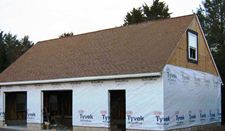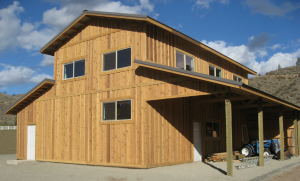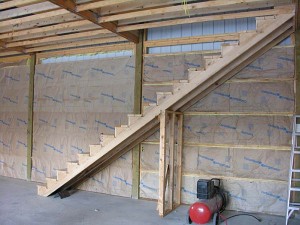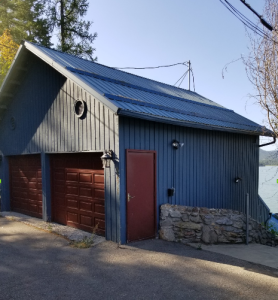Over the past three decades, house wrap has become a staple feature on millions of buildings. Wrapping a wood framed building in a protective envelope is a good building practice which helps combat a building’s worst enemies: water, moisture and air infiltration. House wrap behind a building’s siding is an excellent secondary defense against the weather.
House wrap is a weatherization membrane which provides a protective layer under a building’s siding and over the wall girts or sheathing. It is literally wrapped around a building, cut out around windows and doors and taped at the seams.
The unique, nonwoven-fiber structure of house wrap resists air infiltration and water intrusion, yet is engineered to readily allow moisture vapor to diffuse through the sheet, helping prevent mold and mildew buildup and wood rot. The fibrous structure is engineered with microscopic pores which readily allow moisture vapor to evaporate but are so small bulk water and air cannot penetrate. Siding, whether vinyl, wood, stucco, brick, or composite, does not completely prevent air and water penetration. House wrap is designed as a secondary defense to help manage a building’s wall systems.
 R-Value ratings for insulation are only maintained as long as the air within the insulation stays still and dry. The Department of Energy estimates nearly 40% of a building’s energy loss is the result of air infiltration caused by wind driven pressures from the outside. The opposing forces of pressure between inside and outside walls cause heat and air conditioning to be virtually sucked from a building– through walls, ceilings, sill plates, sheathing joints, top plates, electrical outlets and every inch of the estimated half-mile of cracks in newly constructed buildings. As air infiltrates, it causes changes in temperature which require heaters or air conditioners to work harder. Constant temperature fluctuations also reduce comfort levels. Occupants feel too cold or too warm. Reducing air infiltration increases a building’s comfort factor.
R-Value ratings for insulation are only maintained as long as the air within the insulation stays still and dry. The Department of Energy estimates nearly 40% of a building’s energy loss is the result of air infiltration caused by wind driven pressures from the outside. The opposing forces of pressure between inside and outside walls cause heat and air conditioning to be virtually sucked from a building– through walls, ceilings, sill plates, sheathing joints, top plates, electrical outlets and every inch of the estimated half-mile of cracks in newly constructed buildings. As air infiltrates, it causes changes in temperature which require heaters or air conditioners to work harder. Constant temperature fluctuations also reduce comfort levels. Occupants feel too cold or too warm. Reducing air infiltration increases a building’s comfort factor.
Insulation can help increase the R-value, but it is only marginally effective in reducing air infiltration. When air infiltrates, the R-value itself can be reduced up to 60%. Adding thicker insulation won’t solve the problem. Stopping air from getting in, will.
Properly applied, house wrap helps reduce air infiltration, preserving R-values, conserving energy, reducing heating costs and creating a more comfortable interior.
The tighter the building, the more comfortable and efficient. Unfortunately, the tighter a home, the more susceptible to moisture problems which can cause mold, mildew and rot. So all systems need to be in balance–designed to manage water and moisture effectively.
There are two main ways water and moisture get into wall systems:
Bulk water intrusion from the exterior (rain and snow) can enter the wall and, if not allowed to dry in a reasonable amount of time, can raise the moisture content of the wood above 30% and cause rotting or mold and mildew.
Air transported moisture occurs when air leaks from the warm side of the wall to the cool side. Warm air will hold higher amounts of moisture than cold air. As warm air travels through a wall heading to the cold side, it will begin to cool and be forced to release moisture. This is called the dew point where condensation will occur. When there is a significant temperature drop across the wall, the dew point will occur somewhere within the wall. In the winter months the point of condensation is usually on the inside surface of the exterior sheathing. Moisture carried by air flow through the wall is deposited at the back side of the sheathing and accumulates. In hot and humid climates where air flow is traveling from the outside to the inside, warm moist air from the outside will be cooled on the way to the air conditioned inside, releasing moisture within the wall cavity. House wrap is a breathable membrane with microscopic pores which allow the moisture vapor to dissipate, helping to dry out a wall system to avoid damage.
Moisture Vapor Transmission Rate or perm rate of a material determines the ability for water vapor to diffuse or evaporate through the wall. The higher the perm rate, the more “breathable” the material is and the easier it is for water vapor to pass through. Materials with Perms below 1 are considered vapor retarders since the rate of moisture vapor flow through a 1 Perm material is so low there is essentially no flow. House wraps have Perm rates in the area of at least 58 Perms which is very open to allow moisture vapor to flow through.
What house wrap is not, is a vapor barrier or an insulation. I’ve seen instances where people have applied house wrap directly between roof purlins and roof steel, in an effort to control condensation. House wrap is quite permeable; any warm moist air which would rise to it will pass through to the underside of the roof steel and condense.
House wrap is great…if used for what it was intended for…a secondary defense against the weather.










Mike
Will the A1V insulation used on the roof of my Hanson building be suitable to use on the enclosed area between the wall girts and wall steel or do you recommend something different? I will be insulating the inside walls and ceiling, finishing out with sheet rock. Climate here is hot and humid in the summer and rarely freezes in the winter.
Thanks.
Bo
Bo ~
Housewrap would be the best product to use between the wall girts and the siding.
Built 20×30 horse pole barn for horse’s, clay floor, wood exterior metal roof on purlings with no moisture barriers. No plans to insulate need moisture barrier for sure and something for sound abatement, what do we use? Thank you Di
Di ~ You should most certainly have an insulated vapor barrier between the roof purlins and the roof steel. Here is the link to a superior product (it includes a pull strip on the overlaps, which has adhesive under it): https://www.buyreflectiveinsulation.com/a1v_reflective_foil_insulation.php
Question about a pole barn that has an apartment in it. Just bought a house that has a pole barn with an apartment that is about 80% completed. It has metal exterior walls, fiberglass insulation with kraft paper and interior wall is plywood with sheetrock on top of that. There is not a vapor barrier and a friend told me that the way it is built could cause condensation and possible mold. If he is correct, what are some options to correcting the build?
Heath ~ If you placed a wager with your friend – go collect on it. The kraft paper on the inside of the fiberglass insulation IS a vapor barrier. AS long as it was properly installed with tight seams, you should have a workable vapor barrier, which will keep the warm moist air from the inside of the building out of the wall insulation cavity. If there is not a good house wrap on the outside of the building, you should go invest in some. Take a wall of steel off at a time and place the house wrap on the outside of the wall framing, making sure to properly seal all seams, then reinstall the siding. Yes, it is a pain, however it is the right way to do things in order to reduce the potential for challenges down the road.
So I’m a little confused. In the article it says “I’ve seen instances where people have applied house wrap directly between roof purlins and roof steel, in an effort to control condensation”,as if that is a bad thing, but in these comments it seems like that is what is recommended. I just finished framing my pole barn and was going to put house wrap on before applying the steel siding. Later I was going to put up face fiberglass roll insulation with the open side against the house wrap and the faced side down. Is this not the correct way to do this. Thanks in advance.
Michael ~ The place for the housewrap IS between your building’s wall girts and the steel siding. Housewrap is a weather barrier, so it will keep any weather which might get behind the siding out, while allowing moisture inside of the wall to pass through to the exterior.
In the roof = bad, in the walls = good.
I have an out building that is 20 years old and completely finished on the inside with just a vapor barrier between the rock and insulation and the siding is 8″ lap cedar. The building was never wrapped. I need to replace the siding on one side but not sure if I should wrap it or not. The building is primarily used for storage. What should I do?
When in doubt, always place house wrap between siding and the underlying structure.
I plan on installing over my purlins, insulation, tyvek, then the metal roofing / Sidding. Would this be the correct sequence?
On the roof, you should be using either a Radiant Reflective Barrier, steel with Dripstop/Condenstop or spraying closed cell foam insulation on the underside of the roof steel to prevent condensation. Tyvek (or any Weather Resistant Barrier) should not be used under the roof steel as it allows moisture to pass through and become trapped between the WRB and the roofing. Insulation should not be installed over the roof purlins as it will negatively affect the shear strength of your roofing.
Walls – install Weather Resistant Barrier between framing and steel siding. Fill insulation cavity with unfaced fiberglass or rock wool.
Roof system – use raised heel trusses and blow in fiberglass insulation above the ceiling.
Mike, My pole barn has a Radiant Reflective Barrier between the purlins and roof steel, but does not have house wrap on the walls. As you said, the correct way is to remove the metal on one wall at a time, install house wrap and tape the edges. Would it be possible to wrap the inside of the barn walls with house wrap? Place it on the inside of the wall girts, and continue around the inside of the post. I would still think the wall cavity would have a Weather Resistant Barrier even though the house wrap was on the inside of the wall girts and post, instead of the outside? Please correct me if I’m wrong!
The idea is to have the wall dry to the outside, wrapping as you describe could allow moisture to be added into girts and columns. This could prove especially problematic in the case of untreated wall girts and could lead to mold, mildew and premature decay.
My post frame building doesn’t have house wrap on the walls and would like to avoid removing the metal to install house wrap. According to what I’ve read, the most expensive alternative is spray foam, and the second most expensive is Roxul. Would any, or all of the following options be an acceptable alternative? I can do one of the following options myself.
1. Wrapping the inside of the wall girts and post with a good quality house wrap and taping all seams?
2. EPS (Expanded Polystyrene Insulation) place 1-1/2” EPS unfaced between the wall girts leaving a 3/8″ gap and filling the gaps with Great Stuff spray foam? If EPS won’t work is there an alternative that will?
3. BIB’s Insulation?
4. EPS unfaced between the post on the inside of the wall girts leaving a 3/8” gap and filling all the gaps with Great Stuff spray foam? If EPS won’t work, is there an alternative that will?
5. Is there any other viable options that I didn’t mention?
* #1, 2, and 4 would be followed with BIB’s Insulation, then drywall.
(The building has a radiant reflective barrier between the purlins and roof metal) The trusses have a BCLL of 5 and will be installing drywall on the ceiling, then blowing in cellulose or fiberglass at a minimum of R-49. (A vapor barrier in the ceiling is a NO, NO, and will NOT be using it!)
James from Central Indiana
I have to vote for closed cell spray foam – consider it as an investment rather than an expense. Two inches will run around $2 a square foot.
Hello I had a question on fastening house wrap. Would you recommend using button staples vs just tack hammer staples. On houses the button staples or nails are a standard but I didn’t know if the button would show through steel in pole buildings. We live in a very windy part of the country so want to prevent the house wrap from coming down but also do not want to have the button show through on the new shop.
Tack hammer staples and install steel over the house wrap immediately.